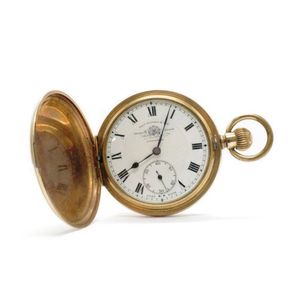
David Flattery- Elgin Thos. Russell Liverpool Stem Wind Fob Watch
David Flattery- Elgin for Thos. Russell Liverpool stem wind fob watch. 10 Jewel movement running when tested. Approx case width 53 mm

Antique Elgin Gold Fob Watch with Safety Pinion Keystone Case
Antique Elgin gold filled fob watch marked Safety pinion Elgin 4152733, keystone case. Approx case width 40 mm

Elgin 14ct Gold Ladies Hunter Pocket Watch with Engine-Turned Design
Elgin 14ct gold ladies hunter pocket watch with engine-turned design to gold case and second subsidiary dial. Crack to face. Weight 40.6 grams. Stem wind, working when tested. 3.6 cm diameter.

Antique Elgin 18ct Gold Hunter Pocket Watch, Not Working
Antique ladies Elgin 18ct gold hunter pocket watch with engine-turned design, shield and engraved town dock scene. Weight 65.5 grams. Stem wind, not working. 4.4 cm diameter. Movement marked ladys Elgin No.37551.

Vintage Florida Gold Filled Pocket Watch with 15 Jewels
'Florida' gold filled pocket watch. 15 'Rubis' jewel, open face Illinois Watch Co. for Elgin 10 year case. Running, case worn, plexi yellowed. Serial no. 128935.

Elgin Art Deco Gold Pocket Watch, Engraved 1924 Gift
Art Deco Elgin gold gentlemans pocket watch, 14ct yellow gold full hunter pocket watch, machine turned decoration with central buckle and initials, internal white enamelled dial with seconds movement, in working condition. Engraved to inner reverse.…

Elgin Gold Plated Half Hunter Pocket Watch, Made in USA
Elgin gold plated pocket watch, half hunter watch with enamel Roman numerals to case, white dial with black numerals, made in USA

Elgin 14ct Gold Hunter Cased Pocketwatch, Circa 1900
Elgin a 14ct gold hunter cased pocketwatch circa 1900. Dial: white enamel Roman, sunk Arabic seconds dial at 6, blued steel hands. Movement: gilt lever movement, no.1463517. Case: engraved with floral and ribbon decoration, cuvette and case numbered 27218…
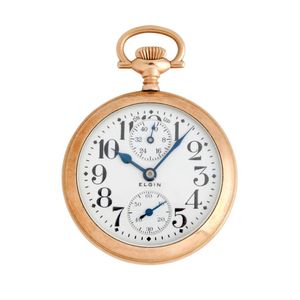
Elgin Veritas Gold Filled Railroad Watch with Winding Indicator
Elgin Veritas a gold filled Openfaced Railroad grade watch with Winding Indicator. Dial: white enamel, large Arabic numerals, subsidiary seconds, forty hour winding indicator, blued steel railway spade hands. Movement: damascened 23-jewel bridge pattern…
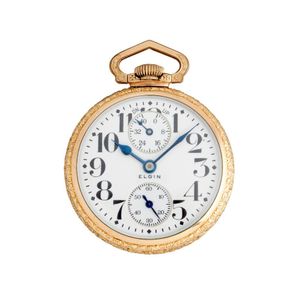
Elgin Gold Filled Railroad Grade Watch with Winding Indicator
Elgin Watch Co. A gold filled Openfaced Railroad grade watch with Winding Indicator. Dial: white enamel, bold Arabic numerals, subsidiary seconds, forty hour winding indicator, blued steel railway spade hands. Movement: damascened 21-jewel bridge pattern…

Non-working Elgin Diplomat open face pocket watch in silver case
Elgin Diplomat open face pocket watch in a silver plated case. Not working.
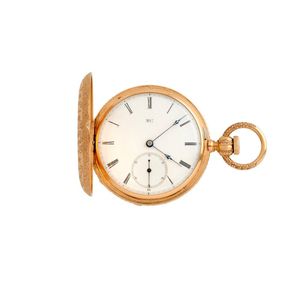
Elgin Lady Elgin 18ct Gold Pocket Watch, Circa 1870
Elgin lady Elgin an 18ct gold hunting cased pocket watch circa 1870. Dial: white enamel Roman, Arabic sunk seconds dial, blued steel tulip hands. Movement: gilt lever movement, key-wind, key-set, no. 00171. Case: fully engraved and engine-turned floral…

Elgin Antique Pocket Watch in Engraved Rolled Gold Case
Elgin antique pocket watch in finely engraved rolled gold case, with crown wind and subsidiary dial, 19th century, 8 cm high overall

Elgin 10ct Gold Hunter Pocket Watch with White Enamel Dial
10ct gold hunter pocket watch by Elgin, with white enamel Roman dial, rail track minutes, subsidiary seconds. Stem wind. Gold cuvette with presentation engraving. Repaired back cover hinge. Signed and numbered 7 jewel movement. Total weight 84gm.

Elgin 18ct Gold Hunter Pocket Watch with Enamel Dial
18ct gold hunter pocket watch by Elgin, USA, with white enamel dial, Roman numerals, rail track minutes, sunken centre and sunken subsidiary seconds dial at VI. Stem wind at III. Gold cuvette Signed and numbered 17 jewel movement. Total weight 108gm.

Antique 18ct Yellow Gold Elgin Fob Watch, Circa 1910
Ladies antique 18ct yellow gold fob Elgin watch. Marked 18k 750 Fine to case and back plate.33.7 grams, case width 33 mm, stem wind movement runs & stops circa 1910

Elgin 14ct Yellow Gold Hunter Pocket Watch, Working Condition
An early 20th century Elgin 14ct yellow gold hunter pocket watch, the white enamel dial with Arabic numerals, subsidiary seconds and fine hairline cracks. Engraved covers, 14ct dust cover, the 17-jewel movement working. 68.5gm.
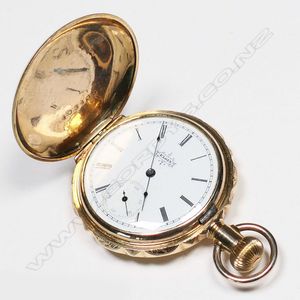
Gold Plate Ladies Hunter Pocket Watch with Floral Engravings
An Elgin gold plate ladies fancy hunter pocket watch, the covers applied and engraved in coloured gold, the back with bird and florals. Diameter 42 mm.
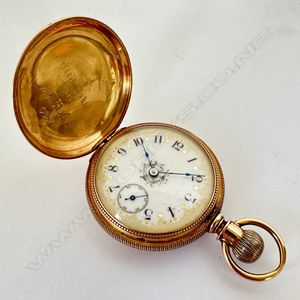
Elgin 14ct Hunter Pocket Watch with Engraved Deer Design
Substantial 14ct hunter pocket watch by the Elgin Watch Co., Illinois, USA 53 mm case, engraved front with monogrammed cartouche, engraved back cover with deer in landscape, milled patterned band. Inside back cover stamped 'Warranted 14K U.S. Assay'.…
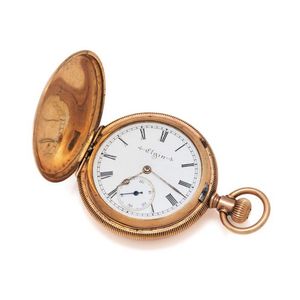
1906 Elgin Hunter Case Pocket Watch in Gold Fill
'Elgin' hunter case gold filled pocket watch. Serial #12219410 circa 1906.
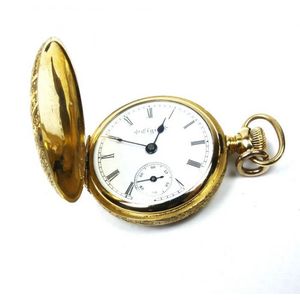
Elgin Ladies 18ct Gold Pocket Watch
Elgin ladies pocket watch having a white dial with subsidiary dial. 18ct yellow gold engraved case manual wind movement. 34 mm case diameter.
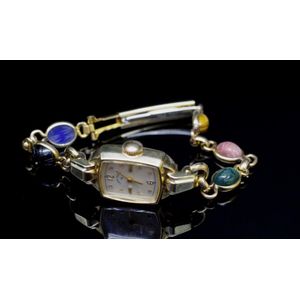
Scarab Gemstone Ladies Elgin Watch with 19 Jewel Movement
Carved scarab gemstone set ladies Elgin watch 19 jewel movement runs and stops. Gemstones includes, bloodstone, tigers eye quartz and rhodonite

Antique Elgin Silver Fob Watch, Working Movement (9 words)
Antique silver Elgin fob watch marked Elgin 800 #4444889. Circa 1891, case width 51 mm, stem wind movement working when tested

Elgin Hunter Pocket Watch in 10ct Gold, 19th Century
Elgin full hunter gents pocket watch in 10ct gold case with crown wind movement, 19th century, 6.5 cm high overall

Elgin Vintage Pocket Watch in Rolled Gold Case with Box
Elgin vintage pocket watch in 10ct rolled gold case, with original lithographed card box, early 20th century, 6 cm high overall
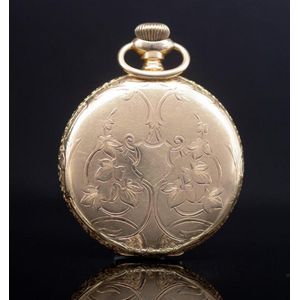
Antique Elgin 14ct Yellow Gold Fob Watch, Circa 1905
Antique Elgin 14ct yellow gold fob watch marked 14k and 14k fine to the case and back plate. Movement Elegin Natl watch Co. 117179**, case width 47 mm, weight of item 85 grams. Stem wind mechanism working when tested. Circa 1905
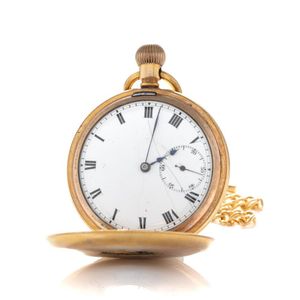
Elgin Half Hunter Pocket Watch with Gold Plated Chain
An Elgin half hunter pocket watch, white dial (2 hairline cracks) Roman numerals, subsidiary seconds, 7 jewel stem wind and set movement, gold plated case, back cover worn, size 50 mm, working, with gold plated chain.
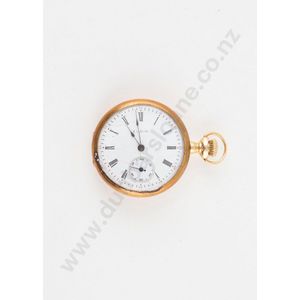
Elgin 14ct Open Face Fob Watch with Engraved Back
Elgin USA 14ct cased open face lever wind fob watch white dial with seconds movement initial engraved back cover
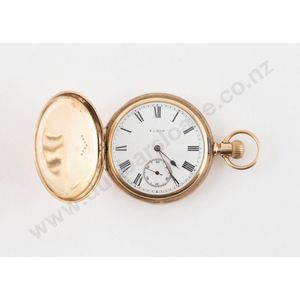
Elgin Hunter Case Pocket Watch with Roman Numerals
Elgin USA 10ct hunter cased lever wind pocket watch white enamel dial with Roman numerals and seconds movement
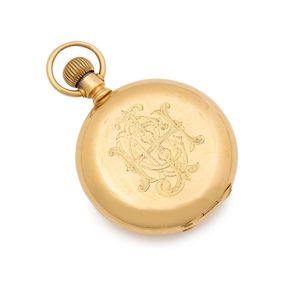
1880 Elgin 18k Gold Pocket Watch with Hunter Case
An 18-carat gold Elgin pocket watch, USA, circa 1880, 21 jewel, crownwind lever set, full plate high grade, double back, railroad quality, a jewel to the centre wheel, enamel dial with Roman numerals, in a hunter case, 53 mm diameter
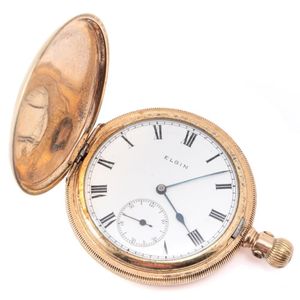
Elgin 14ct Gold Plated Full Hunter Pocket Watch C.1912
An Elgin 14ct gold plated full hunter pocket watch, white dial, Roman numerals, subsidiary seconds, stem wind and set, 15 jewel movement, case diam. 51 mm, missing bow, working, C - 1912.
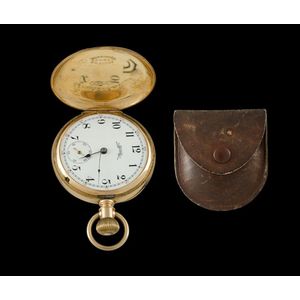
Elgin 18K Hunter Case Pocket Watch
Elgin 18K pocket watch. Hunter cased. Movement serial number 2799353. Crystal non-extant. Arabic numerals. W60g total)

Antique Elgin Ladies Fob Watch - Gold Plate
Antique Elgin ladies fob watch marked 11835772. Approx width 37 mm, working when tested.Tests as gold plate

Engraved Elgin Hunter Pocket Watch
A lady's 10ct. gold Elgin hunter pocket watch, the case with profusely engraved decoration, the white enamel dial with Roman numerals and seconds dial, stem wind, in working order. Diameter 3.4 cm. Gold internal dust cover. Total 33.7gm

14k Elgin Open Face Pocket Watch - Working Mechanism
Antique 14ct yellow gold open face pocket watch marked 14k Elgin. 283,40032, 6114128 approx case width 44 mm, weight 52 grams. Monogrammed Esp. Stem wind mechanism working when tested

Elgin American 14ct Gold Full Hunter Pocket Watch Set
Elgin American full hunter pocket watch in 14ct gold case, plus accompanying gold plated Albert chain and fob seal, 19th century, bezel 5 cm diameter

Elgin Pocket Watch Set with 9ct Gold Accessories
Elgin pocket watch in 9ct case with 9ct fob chain and 9ct Tasmania fob
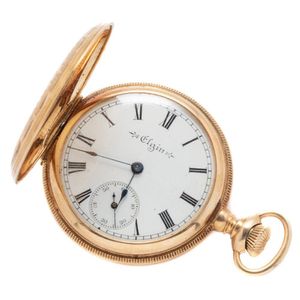
Antique 14ct Gold Elgin Pocket Watch, C. 1902
An antique 14ct gold lady's Elgin pocket watch, white enamel dial with Roman numerals subsidiary seconds dial and blued hands on a 7 jewel movement signed. Elgin Nat. Watch Co. USA, no 10926821, not working, in 33 mm wide engraved and engine turned case,…
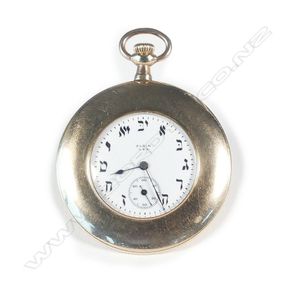
Hebrew Dial Elgin Ultra Slim Pocket Watch
An Elgin ultra slim gold plated pocket watch with Hebrew dial, annular disc form with white enamel dial with Hebrew characters and subsidiary seconds dial at vav, presentation engraving dated 1917 to the back, diameter 4.7 cm.

Elgin Pocket Watch, 1920s, 14ct Gold, 17 Jewels
A pocket watch, Elgin. USA. Circa 1920's. 42 mm. 17 Jewels. Case number 047511. Movement number 30523973. Second's subdial at 6 o'clock. 14ct gold. Weight 72.16 grams. Gold filled curved chain weight 15.55 grams.

Elgin Pocket Watch with Enamel Dial and Engine Turned Case
Elgin open face pocket watch, with circular white enamel dial set with Arabic numerals, with subsidiary seconds dial, in an engine turned case decorated with c-scroll cartouche, serviced

Elgin Art Deco 14K Gold Fob Watch, Working
Art Deco 14ct yellow gold open face fob watch by Elgin. marked 14k to the case back and plate, diameter 43 mm, total weight 50 grams, stem wind mechanism working when tested.
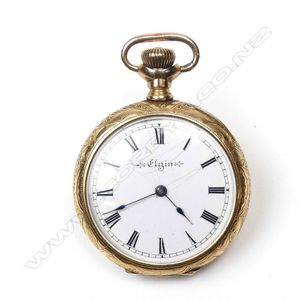
Elgin 14ct Gold Lady's Pocket Watch
A 14ct gold open face lady's pocket watch, by Elgin Watch Co, lever wind, white enamel dial. Gold dust plate, diameter 3.4 cm, total 33gm.

Antique 18ct Gold Elgin Pocketwatch with Engraved Case
A gold Elgin pocketwatch, crown wind, lever set, circular white dial with black Roman numerals, subsidiary seconds at six, 18ct gold engraved case, diameter 51 mm, circa 1800. Engraving to interior 'W.J.Smith'.
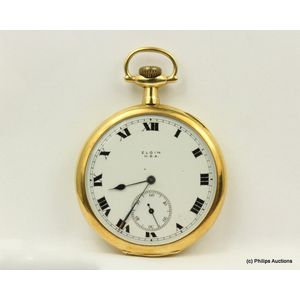
18ct Gold Elgin Pocket Watch with White Enamel Dial
A gold Elgin pocket watch. 18ct yellow gold, case hallmarked and numbered 5269188, hallmarked curvette with signed Elgin 17 jewel movement, numbered 15871655, white enamel dial black Roman numerals, blued steel hands, subsidiary at 6 o'clock, marked Elgin…
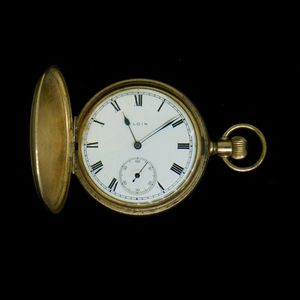
Elgin Hunter Pocket Watch, 7 Jewel, Gold Filled
Elgin hunter case pocket watch. 7 jewel, gold filled. Serial #16043700

Elgin Ladies 14k Gold Pocket Watch - A/F
14ct yellow gold ladies Elgin pocket watch with a stem wind mechanical movement, the minute hand is detached. Marked 14k. Approx diameter 32 mm, total weight 29 grams including base metal jump ring. Working when tested, A/F to case

Elgin 18ct. Yellow Gold Full Hunter Pocket Watch
An early 20th century Elgin 18ct. yellow gold full hunter pocket watch, stem wind, the white enamel dial with Roman numerals, subsidiary seconds, apparently working. In original fitted case. 109gm.

Antique Elgin Full Hunter Pocket Watch in Rose Gold
An early 20th century 10ct. rose gold Elgin full hunter pocket watch, stem wind, white enamel dial, Roman numerals, subsidiary seconds, not working. 92.9gm., in original case.
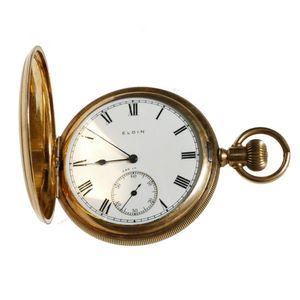
Elgin Gold Plated Hunter Pocket Watch, Working Condition
An Elgin gold plated hunter cased pocket watch, 7 jewel movement, dial with Roman numerals, railtrack minutes, subs-seconds at VI, diameter 5 cm, apparently working.
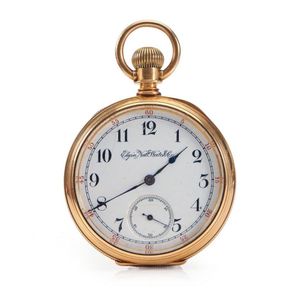
Elgin Gold Pocket Watch with Coat of Arms
An Elgin watch Co. Open face gold pocket watch, crown wind, lever set, reversible movement, circular white enamel dial with Arabic numerals, subsidiary seconds dial at six, dial and movement signed Elgin Natl. Watch Co, 18ct gold case inscribed B.W.C.Co,…

Elgin Rose Gold Full Hunter Pocket Watch
An 18ct rose gold Elgin full hunter pocket watch, stem wind, the white enamel dial with Roman numerals and seconds dial, marked Elgin Nat'l Watch Co., in working order, weight including movement 132gm.

Elgin Pocket Watch with Sterling Silver Fob Chain
A gold plated pocket watch, the white enamel dial marked 'Elgin', attached to a sterling silver fancy links fob chain. Length 35 cm

Elgin Rose Gold Pocket Watch with White Dial
An Elgin rose gold plate gentleman's pocket watch, white dial, black Roman numerals, second subsidiary dial
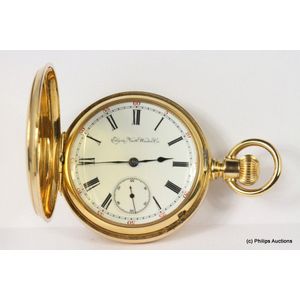
18ct Elgin Full Hunter Pocket Watch
A solid 18ct yellow gold Elgin full hunter pocket watch. 18ct yellow gold, hallmarked to case and movement, case no 471655, made by Elgin watch Company. The full hunter with polished outer case, initials motif, white enamel dial, black Roman numerals,…

Antique Elgin Ladies Watch in Rose Gold Plate Case
Antique Elgin ladies watch in well engraved and rose gold plate case. Circa 1886-7. Approx case diameter 40 mm. Watch working when tested

Elgin Pocket Watch with Gold Plate Fob Chain
Elgin gold plate open face pocket watch white enamel dial with black Arabic numerals and subsidiary seconds dial. Stem wind. 51 mm diameter. Seven jewels, movement marked Elgin Natl Watch Co. USA. Working when tested. Comes with a gold plate fob chain
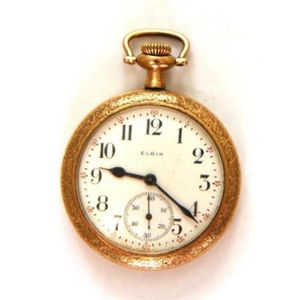
Elgin Rolled Gold Pocket Watch with Subsidiary Dial
An Elgin rolled gold pocket watch, white dial, black Arabic numerals and hands, second subsidiary dial, stem wind movement

Gold Medallion and Pocket Watch for Football Loyalty
A 9ct gold medallion engraved 'K.R.F.C.1 (believed to be Kennett river Football Club) 'Premiers 1907 M. Connelly', also, a gold-plated Elgin pocket watch (working but lacking the glass face) engraved1Presented to Mick Connelly for his Services & Loyalty…

Elgin Rolled Gold Hunter Pocket Watch, Working Condition
Elgin rolled gold hunter pocket watch white enamel dial with black numerals and subsidiary seconds dial. Stem wind. 51 mm diameter. Seven jewels, movement marked Elgin Natl Watch Co. USA. Working when tested.

Elgin Gold Plated Hunter Pocket Watch with White Dial
Elgin gold plated hunter pocket watch white enamel dial with black roman numerals and subsidiary seconds dial. Stem wind. 51 mm diameter. Working when tested.

Elgin 10ct Gold Lady's Full Hunter Pocket Watch
An Elgin 10ct gold lady's full hunter pocket watch, white enamel dial, black Roman numerals, subsidiary seconds, stem wind and set plate movement, finely engraved case front panel with monogram, case diam. 40 mm, C - 1890, rolled gold attachments, wt. 54…

Elgin Engraved Gold Fob Watch with Cracked Dial
Elgin gold fob watch with an profusely engraved and engine turned case approx diameter 54 mm . 15 jewel mechanical movement working when tested. Some cracking to the enamel dial

Elgin Gold Pocket Watch with Ruby and Diamonds
Elgin 14ct gold, ruby and diamond pocket watch, with a white enamel dial, with Roman numerals, and subsidiary dial set with in gold case beautifully engraved with chased cupid holding torch set with ruby, verso chased with shield medallion, total weight…

Lord Elgin 10ct Gold Chronometer with Arabic/Baton Numerals
Lord Elgin chronometer, 10ct gold case, Arabic and baton numerals

Blue Enamel Half Hunter Pocket Watch by Caris Bros
A ladies half hunter pocket watch, 14ct gold case with blue enamel external numerals and crown wind, 19th century, dial marked for Caris Bros. Retailers, movement marked 'Elgin Nat'l Watch Co. U.S.A', subsidiary seconds dial. 3.5 cm diameter

Assorted Watches: Hunter, Sterling Silver, Auto Wrist
Three various watches. Incl. Elgin full hunter ename faced, Gf fob watch, running; American watch Co 'Bond' Street full hunter enameled faced, English sterling silver cased fob watch, running; & Neuchatel mens auto wrist watch in Gf case. Faceted fancy…

Elgin 10ct Gold Hunter Pocket Watch with 15 Jewels
A full hunter Elgin pocket watch, 10ct yellow gold cased, marked to dial Elgin with white enamel dial and black Roman numerals, fitted with Elgin National 15 jewel movement, no 16434085 Crown wind.

Engraved Elgin Fob Watch with Working Manual Wind Mechanism
Antique Elgin fob watch with a well engraved gold plate case with birds and floral scenes. Manual wind mechanism was working when tested

Gold Plated Elgin Pocket Watch with Roman Numerals
An Elgin gold plated pocket watch, white dial, black Roman numerals & hands, second subsidiary dial, manual wind movement

Elgin Full Hunter Pocket Watch in 10ct Gold Filled
A gents full hunter Elgin pocket watch, 10ct yellow gold filled, presented as a full sized hunter with engine turned case and shield motif, case no 5292335, crown wind, white enamel dial, black Roman numerals, sub dial, blued steel hands, fitted with…
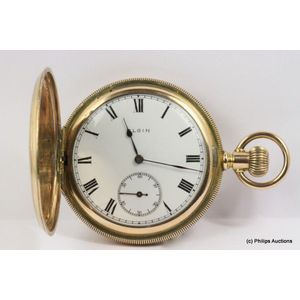
Elgin Hunter Pocket Watch with Keystone Case
A full hunter pocket by Elgin, yellow gold plated, with engine turned case, central cartouche, crown wind, opening to white enamel dial, black Roman numerals, Elgin Nat'l watch Company USA. 15 jewel movement 17979626 Keystone case USA no. 8455855. Total…

Elgin Half Hunter Gold Plate Watch
Elgin half hunter watch, gold plate case with enamelled roman numerals and glass window. Blued steel hands, white dial with subsidiary second dial. Stem manual movement. Was running when tested
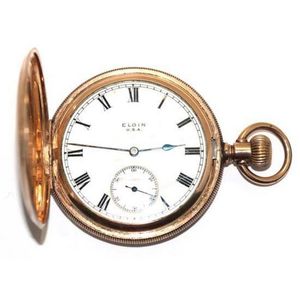
Elgin Gold Plated Pocket Watch with Roman Numerals
An Elgin gold plated pocket watch, white dial, black Roman numerals and hands, second subsidiary dial, gold plated clasp, manual wind movement

Elgin Full Hunter Pocket Watch, Working Condition, Loose Glass
Elgin gilt metal full hunter pocket watch glass loose. working when tested
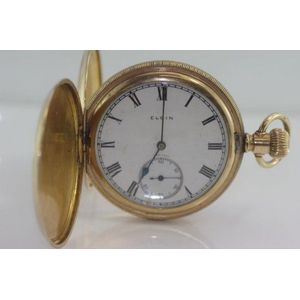
Elgin Full Hunter Pocket Watch in Keystone Case
Elgin gilt full hunter pocket watch, in Keystone case

Elgin Antique Gold Plated Full Hunter Pocket Watch
Antique gold plated full hunter pocket watch, white enamel dial marked Elgin, with applied gold design of bird and flowers to front, hands missing or bent, watch ticking when wound

Elgin Full Hunter Pocket Watch with Keystone Case and Inscription
10K gold Elgin full hunter pocket watch, in a Keystone case, inscribed inside 'To Wallace from Kathleen 19-8-16', cracked across watch 'crystal

Elgin USA Hunter Case Pocket Watch with White Dial
10ct hunter cased small pocket watch white enamel dial by Elgin USA

Rose Gold Elgin Pocket Watch by Keystone (28.3g)
A 10ct rose gold pocket watch, dial marked Elgin, the case marked Keystone. Diameter 3.2 cm. Total weight 28.3g
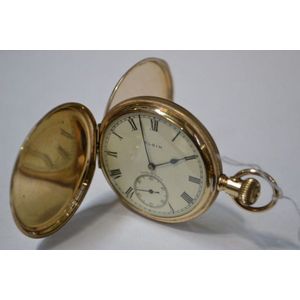
Elgin 1930s 9ct Gold Fob Watch with Inscription, Working
9ct gold fob watch by Elgin c.1930 with inscription on the inside (in working condition)

18ct Gold Elgin Pocket Watch with Full Hunter Case
Ladies 18ct gold Elgin full hunter pocket watch, white enamel dial, with black numerals. Total weight 32gms.

Swiss Movement Rolled Gold Full Hunter Gent's Watch
Gent's 'The Panama' rolled gold full hunter watch, with Swiss 7 jewels movement, working when tested, the rolled gold case by Illinois Watch Case Co, Elgin, U.S.A

1925 Elgin Hunter Pocket Watch, Incomplete and Non-Functional
Elgin gilt full hunter pocket watch, with inscription for 1925. Glass missing, not working

Octagonal Engraved Elgin Fob Watch with Hinge Fault
14ct open face lever wind fob watch octagonal fine machine engraved case with Elgin movement (fault to hinge)

Elgin USA Hunter Case Pocket Watch with Second Hand
14ct hunter cased lever wind small pocket watch white enamel dial with seconds movement by Elgin USA

Antique Hunter Pocket Watch, Thos. Russell & Sons Liverpool
Full hunter pocket watch Thos_Russel & sons, Liverpool in a Illinois watch case company Elgin, missing glass, not working when tested

Gold Elgin Pocket Watch with White Dial and Subdial
A gold plate Elgin pocket watch, white dial, black Roman numerals & hands with a second subsidiary dial

Elgin Full Hunter Pocket Watch, Gold Plated, Not Working
Elgin full hunter pocket watch, gold plated, internally marked Elgin Natl Watch Co USA, currently not working

Working Ladies Elgin Full Hunter Gilt Pocket Watch
Ladies Elgin full hunter gilt pocket watch, in working order

Elgin Full Hunter Pocket Watch, 1919, Not Working
An Elgin full hunter rolled gold pocket watch, white dial (discoloured plexi) Roman numerals, subsidiary seconds on a 7 jewel movement, C 1919, not running.

Elgin 18ct Gold Full Hunter Pocket Watch
A gentleman's gold full hunter pocket watch, Elgin. 50 mm. Crown wind. Movement number 3717875. Dial and movement signed. White enamel dial, black Roman numerals, subsidiary seconds. Engine turned case. 18ct yellow gold. Total weight 109.04 grams.

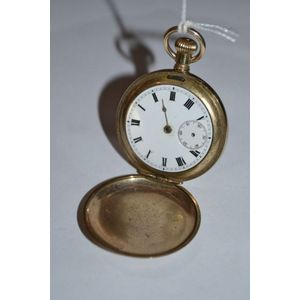

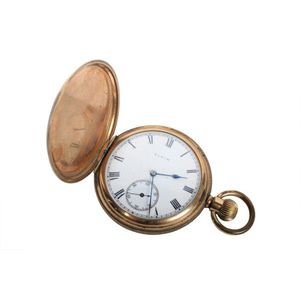
 Loading more...
Loading more...